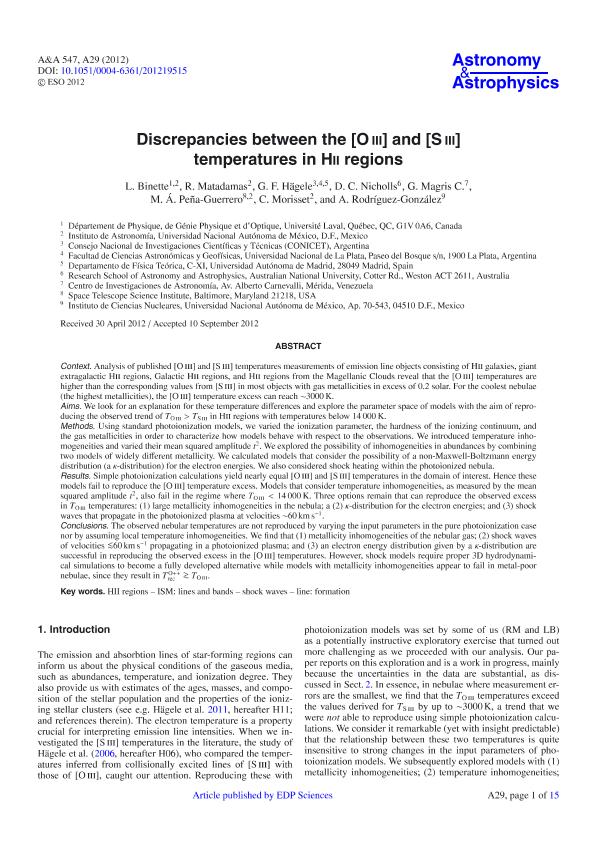Artículo
Discrepancies between the [O iii] and [S iii] temperatures in H ii regions
Binette, L.; Matadamas, R.; Hägele, Guillermo Federico ; Nicholls, D. C.; Magris Crestini, Gladis; Peña Guerrero, M. Á.; Morisset, C.; Rodríguez González, A.
; Nicholls, D. C.; Magris Crestini, Gladis; Peña Guerrero, M. Á.; Morisset, C.; Rodríguez González, A.
 ; Nicholls, D. C.; Magris Crestini, Gladis; Peña Guerrero, M. Á.; Morisset, C.; Rodríguez González, A.
; Nicholls, D. C.; Magris Crestini, Gladis; Peña Guerrero, M. Á.; Morisset, C.; Rodríguez González, A.
Fecha de publicación:
06/2012
Editorial:
EDP Sciences
Revista:
Astronomy and Astrophysics
ISSN:
0004-6361
Idioma:
Inglés
Tipo de recurso:
Artículo publicado
Clasificación temática:
Resumen
Context. Analysis of published [O iii] and [S iii] temperatures measurements of emission line objects consisting of Hii galaxies, giant extragalactic Hii regions, Galactic Hii regions, and Hii regions from the Magellanic Clouds reveal that the [O iii] temperatures are higher than the corresponding values from [S iii] in most objects with gas metallicities in excess of 0.2 solar. For the coolest nebulae (the highest metallicities), the [O iii] temperature excess can reach ∼3000 K. Aims. We look for an explanation for these temperature differences and explore the parameter space of models with the aim of reproducing the observed trend of T O iii > T S iii in Hii regions with temperatures below 14 000 K. Methods. Using standard photoionization models, we varied the ionization parameter, the hardness of the ionizing continuum, and the gas metallicities in order to characterize how models behave with respect to the observations. We introduced temperature inhomogeneities and varied their mean squared amplitude t 2. We explored the possibility of inhomogeneities in abundances by combining two models of widely different metallicity. We calculated models that consider the possibility of a non-Maxwell-Boltzmann energy distribution (a κ-distribution) for the electron energies. We also considered shock heating within the photoionized nebula. Results. Simple photoionization calculations yield nearly equal [O iii] and [S iii] temperatures in the domain of interest. Hence these models fail to reproduce the [O iii] temperature excess. Models that consider temperature inhomogeneities, as measured by the mean squared amplitude t 2, also fail in the regime where T O iii < 14 000 K. Three options remain that can reproduce the observed excess in T O iii temperatures: (1) large metallicity inhomogeneities in the nebula; a (2) κ-distribution for the electron energies; and (3) shock waves that propagate in the photoionized plasma at velocities ∼60 km s -1. Conclusions. The observed nebular temperatures are not reproduced by varying the input parameters in the pure photoionization case nor by assuming local temperature inhomogeneities. We find that (1) metallicity inhomogeneities of the nebular gas; (2) shock waves of velocities 60 km s -1 propagating in a photoionized plasma; and (3) an electron energy distribution given by a κ-distribution are successful in reproducing the observed excess in the [O iii] temperatures. However, shock models require proper 3D hydrodynamical simulations to become a fully developed alternative while models with metallicity inhomogeneities appear to fail in metal-poor nebulae, since they result in T rec O++ T O iii T rec O++ ≳ TO iii. © 2012 ESO.
Palabras clave:
Hii Regions
,
Ism: Lines And Bands
,
Line: Formation
,
Shock Waves
Archivos asociados
Licencia
Identificadores
Colecciones
Articulos(IALP)
Articulos de INST.DE ASTROFISICA LA PLATA
Articulos de INST.DE ASTROFISICA LA PLATA
Citación
Binette, L.; Matadamas, R.; Hägele, Guillermo Federico; Nicholls, D. C.; Magris Crestini, Gladis; et al.; Discrepancies between the [O iii] and [S iii] temperatures in H ii regions; EDP Sciences; Astronomy and Astrophysics; 547; A29; 6-2012; 29-43
Compartir
Altmétricas



